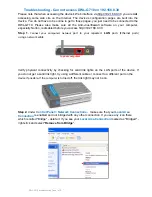
Calculating Volt-Amperage Requirements
To determine the size of UPS that you need:
1 Locate the voltage and amperage requirements for each piece of equipment.
These numbers are usually found on a sticker on the back or bottom of your equipment.
2 Multiply the numbers together to get Volt-Amperes (VA):
VA = Volts x Amperes
3 Add the VA from all the pieces of equipment together to find the total VA requirement.
To determine the minimum volt-amperage requirements for your UPS, we recommend that you add
30% to the total.
UPS Transition Time
UPS transition time
is the time required for the UPS to switch from providing AC power derived from
the utility (or mains) supply to providing AC power derived from the battery backup. (It is sometimes
called
UPS transfer time
.)
UPS transition times vary between UPS models and implementations, but shorter transition times are
preferred. For Extreme Networks stacking products, we recommend a UPS transition time of 20
milliseconds or less to ensure optimum performance and minimize service interruptions.
For high-availability and fault-tolerant installations in which the switches use redundant power supply
units (PSUs), we recommend that each PSU in a switch be connected to a different UPS and that each
UPS be powered by an independent AC supply. This will prevent service interruptions when a power
source is lost, or when a UPS unit fails. (Note that a single, appropriately sized UPS can power PSUs in
multiple switches. The recommendation is simply that for any given switch, the two PSUs should be
connected to different UPS units.)
DC Power Requirements
A DC-powered system should be installed in a DC-I battery return configuration.
Using a DC-I configuration, connect the battery return conductor directly to the central office power
return bus, and not to the equipment frame or the grounding means of the equipment.
The E4G-200 can accept -48 or +24 volts for DC input.
Following Applicable Industry Standards
Always follow applicable industry standards.
For more information, see the following ANSI/TIA/EIA standards:
•
ANSI/TIA/EIA-568-A—the six subsystems of a structured cabling system
•
ANSI/TIA/EIA-569-A—design considerations
•
ANSI/TIA/EIA-606—cabling system administration
•
ANSI/TIA/EIA-607—commercial building grounding and bonding requirements
Site Preparation
E4G Routers Hardware Installation Guide
36
















































